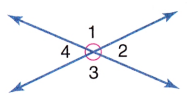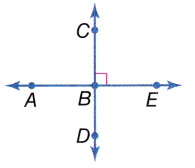Practice questions available in McGraw Hill Math Grade 6 Answer Key PDF Lesson 22.2 Types of Angles will engage students and is a great way of informal assessment.
McGraw-Hill Math Grade 6 Answer Key Lesson 22.2 Types of Angles
Exercises
IDENTIFY
Question 1.
Are the two angles shown below supplementary?

Answer:
Two angles are called supplementary when their measures add up to 180 degrees.
40 + 140 = 180 degrees
Hence the angles shown in the above figure is supplementary.
Question 2.
Are the two angles below complementary?

Answer:
When the sum of two angles is equal to 90 degrees, they are called complementary angles.
25 + 65 = 90 degrees
Hence the angles shown in the above figure is complementary.
Question 3.
Are the two angles A and B supplementary?

Answer:
Two angles are called supplementary when their measures add up to 180 degrees.
The sum of the two angles is 180 degrees.
Question 4.
Are the two angles supplementary?

Answer: No the angles are not supplementary.
Question 5.
Are the two angles CFD and DFE complementary? Why, or why not?

Answer: Yes, two angles CFD and DFE complementary. Because the sum of the two angles is complementary.
Question 6.
Name the two angles below, and determine if they are supplementary.

Answer:
Two angles are called supplementary when their measures add up to 180 degrees.
Question 7.
Determine if the two angles are complementary.

Answer:
When the sum of two angles is equal to 90 degrees, they are called complementary angles.
58 + 32 = 90 degrees
Hence the angles shown in the above figure are complementary.
Question 8.
What size angle would you have to add to make this a right angle?

Answer:
Given angle = 30
Right angle = 90 degrees
30 + x = 90
x = 90 – 30
x = 60
So to make this a right angle we have to add 60 degrees.
Question 9.
In the figure below, list three sets of vertical angles.

Answer:
There are two pairs of vertical angles with intersecting lines, they are across from each other.
∠2 and ∠4
∠1 and ∠3
∠3 and ∠5
∠4 and ∠6
∠6 and ∠8
∠5 and ∠7
Question 10.
Of the angles labeled below, which ones are supplementary?

Answer:
∠5 and ∠2 are the supplementary angles.
Because the sum of two angles is 180 degrees.
Question 11.
List two pairs of vertical angles in the figure.

Answer:
There are two pairs of vertical angles with intersecting lines, they are across from each other.
∠2 and ∠4
∠1 and ∠3
Question 12.
What type of angles are C and B?

Answer:
∠C and ∠B are the supplementary angles.
Question 13.
List two pairs of vertical angles in the figure below.

Answer:
∠ABD and ∠CBE are the vertical angles.
Question 14.
What are the two angles in the figure below? Are the angles complementary? Assume that angle ACB is 90 degrees.

Answer:
The above figure is a right angle.
When the sum of two angles is equal to 90 degrees, they are called complementary angles.
Hence the angles shown in the above figure is complementary.